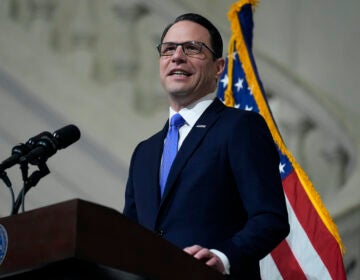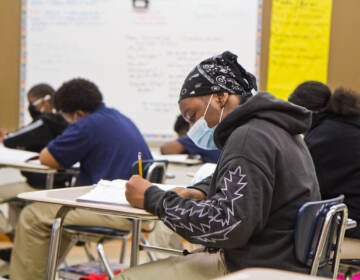Analyzing enrollment trends in Philly schools – district, charter and Catholic

Between this school year and last, K-12 enrollment in the Philadelphia School District fell from roughly 132,000 students to 128,000.
District officials could not provide statistics for students in its alternative schools. In past years, the district educated roughly 4,000 in these schools.
In the same time, enrollment in the city’s brick-and-mortar charter schools grew from roughly 60,500 to 62,500.
About 7,000 Philadelphia children now attend one of the state’s cyber charters.
Over 10 years, district enrollment has declined by roughly 60,000 students, while the charter sector, including cybers, has grown by roughly 47,000.
“It speaks loudly to the choices that are available within the city of Philadelphia. The School District of Philadelphia itself has created many of these choices when it [authorized] charter schools and renaissance charter schools,” said district spokesman Fernando Gallard.
Roughly 13,000 students who are counted in this year’s charter enrollment number attend renaissance schools – where the district believed that rapidly better academic outcomes could be achieved by turning control of one of its schools over to a charter operator.
Gallard said the overall trend, though, has officials concerned.
“We want to be competitive. We want to be able to provide what parents are looking for. Whenever we see students moving away from our schools, we are definitely concerned,” he said. “And that’s why we are creating new choices, and that’s why we are redesigning our schools.”
The school district opened three new non-selective admission high schools in North Philadelphia this year.
It also debuted a school redesign initiative that asked school and community stakeholders to submit proposals for bettering their neighborhood schools. The four schools recently selected will receive a modicum of funding to help advance those plans.
Two more of its neighborhood elementary schools are in the first year of internal turnaround, in which principals were given autonomy to, among other things, replace half of their teaching staffs with other interested members of the Philadelphia Federation of Teachers.
Last spring, the district held a referendum on two low-performing neighborhood elementary schools – allowing parents to vote for or against a renaissance charter conversion. In both cases, after aggressive campaigns from existing school faculty and prospective charter operators, parents overwhelmingly voted to keep their schools within district control.
Education advocates attribute the enrollment decline, in part, to the deplorable funding conditions that have made for regular negative headlines in recent years.
Charters as population preservers?
To Mark Gleason, the numbers indicate that charter schools have helped the city not only maintain, but boost its overall population.
Gleason, executive director of the Philadelphia School Partnership, a nonprofit that awards grants to district, charter and private schools in the city, argues that the large population shift from district schools to charter schools over the past decade has helped Philadelphia avoid the fate of other mid-Atlantic cities where charter growth has been comparatively slow.
He specifically cited census data from Pittsburgh and Baltimore showing losses of 20 and 11 percent, respectively, of school-aged populations over the past decade.
Philadelphia lost only 4 percent in that time.
“The reality in Philadelphia is that charter schools have helped to preserve a school-aged population that might otherwise have left in much greater numbers,” said Gleason.
“That doesn’t hide the fact that we have a huge financial challenge in public education in this city, and we have to solve that,” he added later.
Gleason’s PSP provided funding for the internal turnarounds mentioned above.
For the first time in years, the Philadelphia School District will hear new applications for charter schools this year. It’s received 40 applications, some from operators without a track record of running schools. All will make their cases in public hearings that are slated to begin Dec. 8.
Academically speaking, the city’s charter sector scores about 10 points higher on the state’s School Performance Profile rating, which is based mainly on standardized test scores, with an average score of 64 on the 100-point scale. The state considers 70 as its quality threshold.
Traditional education advocates say that true comparison between the sectors must take into account the fact that, unlike non-renaissance charters, the district’s neighborhood schools must serve all students no matter what time of year they enroll.
Catholic schools
The Archdiocese of Philadelphia, now operating 139 schools in the five-county region, reports a K-12 student population decline of about 2,100 students, from roughly 59,600 to 57,500.
Archdiocese officials see this 3.5-percent decline as good news compared with years past where its schools were losing more than 7 percent of their populations from year to year.
In 2010, the archdiocese served roughly 68,300 students. Since then, it has shuttered and/or merged dozens of elementary schools and developed a more professional enrollment management strategy.
“We’ve stemmed the tide of massive decline,” said Christopher Mominey, secretary of education for the archdiocese.
Mominey is also heartened that, in the archdiocese’s 17 high schools, the freshman cohort is largest and the graduating senior cohort is smallest.
In years past, a low of 52 percent of archdiocesan eighth-graders chose to advance to their parochial high school. This year, the archdiocese estimates that figure will be closer to 65 percent, and aims for it to jump to 85-90 percent by 2018.
Mominey said that the growth and diversity of public school options – especially in the charter sector – have made the Catholic school pitch a tougher sell to parents.
“I think it’s just continuing a focus on quality, so that parents know that the return on their tuition investment is great,” he said. “And we think it is, and we have the data and the stats to prove that in terms of SAT scores and college placements and college scholarships offered.”
Missing 2,000?
Noting that the district’s enrollment dipped by 4,000 and the charter sector grew by 2,000, the question arises: Where did the other students go?
Mominey said that certainly some ended up in archdiocesan schools, but couldn’t confirm an exact number.
The district’s Gallard, who also couldn’t provide a specific number, said it was possible that a portion of these students moved to suburban districts.
Both agreed it was possible that fluctuations in the city’s birth rate could also help account for the difference.
Dale Mezzacappa of the Philadelphia Public School Notebook contributed to this report.
WHYY is your source for fact-based, in-depth journalism and information. As a nonprofit organization, we rely on financial support from readers like you. Please give today.





